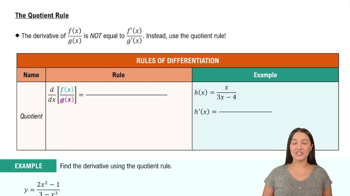Table of contents
- 0. Functions7h 52m
- Introduction to Functions16m
- Piecewise Functions10m
- Properties of Functions9m
- Common Functions1h 8m
- Transformations5m
- Combining Functions27m
- Exponent rules32m
- Exponential Functions28m
- Logarithmic Functions24m
- Properties of Logarithms34m
- Exponential & Logarithmic Equations35m
- Introduction to Trigonometric Functions38m
- Graphs of Trigonometric Functions44m
- Trigonometric Identities47m
- Inverse Trigonometric Functions48m
- 1. Limits and Continuity2h 2m
- 2. Intro to Derivatives1h 33m
- 3. Techniques of Differentiation3h 18m
- 4. Applications of Derivatives2h 38m
- 5. Graphical Applications of Derivatives6h 2m
- 6. Derivatives of Inverse, Exponential, & Logarithmic Functions2h 37m
- 7. Antiderivatives & Indefinite Integrals1h 26m
- 8. Definite Integrals4h 44m
- 9. Graphical Applications of Integrals2h 27m
- 10. Physics Applications of Integrals 2h 22m
3. Techniques of Differentiation
The Chain Rule
Problem 3.7.79
Textbook Question
Applying the Chain Rule Use the data in Tables 3.4 and 3.5 of Example 4 to estimate the rate of change in pressure with respect to time experienced by the runner when she is at an altitude of 13,330 ft. Make use of a forward difference quotient when estimating the required derivatives.
 Verified step by step guidance
Verified step by step guidance1
Identify the function that relates pressure to altitude and time. Let's denote pressure as P, altitude as A, and time as t. We are interested in finding dP/dt, the rate of change of pressure with respect to time.
Recognize that the pressure P is a function of altitude A, which in turn is a function of time t. Therefore, we can express this relationship as P(A(t)).
Apply the Chain Rule to find dP/dt. According to the Chain Rule, dP/dt = (dP/dA) * (dA/dt). This means we need to find the derivative of pressure with respect to altitude, dP/dA, and the derivative of altitude with respect to time, dA/dt.
Use the forward difference quotient to estimate dP/dA. If the table provides pressure values at different altitudes, use the formula (P(A2) - P(A1)) / (A2 - A1) where A2 and A1 are altitudes close to 13,330 ft.
Similarly, use the forward difference quotient to estimate dA/dt. If the table provides altitude values at different times, use the formula (A(t2) - A(t1)) / (t2 - t1) where t2 and t1 are times close to the time of interest. Multiply the results from the previous two steps to estimate dP/dt.
 Verified video answer for a similar problem:
Verified video answer for a similar problem:This video solution was recommended by our tutors as helpful for the problem above
Video duration:
7mPlay a video:
Was this helpful?
Key Concepts
Here are the essential concepts you must grasp in order to answer the question correctly.
Chain Rule
The Chain Rule is a fundamental theorem in calculus that allows us to differentiate composite functions. It states that if a function y is composed of two functions u and x (i.e., y = f(u) and u = g(x)), the derivative of y with respect to x can be found by multiplying the derivative of y with respect to u by the derivative of u with respect to x. This rule is essential for understanding how changes in one variable affect another through a relationship.
Recommended video:

Intro to the Chain Rule
Forward Difference Quotient
The Forward Difference Quotient is a numerical method used to estimate the derivative of a function at a specific point. It is calculated by taking the difference in function values at two points, divided by the difference in the independent variable. This method is particularly useful when dealing with discrete data, as it provides an approximation of the instantaneous rate of change, which is crucial for analyzing rates in real-world scenarios.
Recommended video:

The Quotient Rule
Rate of Change
The Rate of Change refers to how a quantity changes in relation to another quantity, often expressed as a derivative in calculus. In the context of the question, it specifically pertains to how pressure changes with respect to time as the runner ascends to a certain altitude. Understanding this concept is vital for interpreting the behavior of physical systems and making predictions based on observed data.
Recommended video:

Intro To Related Rates

 5:02m
5:02mWatch next
Master Intro to the Chain Rule with a bite sized video explanation from Callie
Start learningRelated Videos
Related Practice






